Simulation of the Spatial Flow of Wind Erosion Prevention Services in Arid Inland River Basins: A Case Study of Shiyang River Basin, NW China
Abstract
:1. Introduction
2. Study Area
3. Data and Methodology
3.1. Data Source
3.2. Methodology
3.2.1. Research Framework
3.2.2. Calculation of the Volume of WEP
3.2.3. Modelling of Spatial Flows of WEP Services
4. Results
4.1. Characteristics of Spatial and Temporal Distribution of WE Volume
4.1.1. Potential WE
4.1.2. Actual WE
4.2. Characteristics of the Spatial and Temporal Distribution of WEP Services
4.3. Spatial and Temporal Characteristics of WEP Service Flows
4.3.1. Transboundary WEP Service Flow
4.3.2. Changes in the Flow of WEP Services within and Outside the Basin
4.4. Spatial Patterns of Supply and Benefit Regions for WEP Service Streams
5. Discussion
5.1. Validation of Results
5.2. Policies and Implications
5.3. Shortcomings and Prospects
6. Conclusions
- The SRB as a whole is moderately eroded, showing a differential distribution pattern decreasing from upstream to the downstream. From 2005 to 2020, the potential WE and actual WE amount both showed an escalating and then declining pattern. The risk of potential WE in SRB continued to decrease upstream, fluctuated, and changed downstream; the area of severe and mild erosion was the largest, and the actual WE amount condition within the watershed was highly polarized. Spatially, the actual WE amount was similar to the potential WE, with the low-value area concentrated in the vast southern region with higher vegetation cover and higher precipitation, and the high-value area located in the desert region with arid climate and low vegetation cover, as well as in the eastern desert–oasis interspersed zone.
- From 2005 to 2020, the WEP services in SRB showed a differential distribution pattern from upstream to downstream, and a tendency of reducing, then increasing, then decreasing sand fixation overall was seen. The areas with higher sand fixation were mainly concentrated in the northeastern part and the junction zone between the oasis area and desert in the eastern part, and the amount of sand fixation in the north and south sides had a significant increase in the study period. In the watershed, Minqin County has the highest-density WEP services. The basic pattern of WEP rate in the same period is completely different from that of WEP services, showing a high south and low north trend, and meteorological factors have a great influence on the WEP capacity of SRB.
- The routes of WEP service flows in SRB show a northwest–southeast distribution pattern. In 2005, 2010, 2015, and 2020, the numbers of wind and sand service flow transmission routes recorded were 73, 134, 98, and 59, respectively, and the wind and sand records were mainly concentrated from March to May. WEP service flow has a very strong spatial extraterritorial effect, and the most important beneficiary regions of the WEP service flow in SRB are Gansu Province, Ningxia Hui Autonomous Region, and Inner Mongolia Autonomous Region. Among them, the routes were the most numerous and the flow range was the largest in 2010. The supply region of WEP and fixation services in the study area is contained within the beneficiary region, with significant cross-border beneficiary effects, and the largest beneficiary region in 2010, involving 47 cities in 9 provinces.
Supplementary Materials
Author Contributions
Funding
Institutional Review Board Statement
Informed Consent Statement
Data Availability Statement
Conflicts of Interest
Abbreviations
| Abridged | Full name |
| RWEQ | Revised wind erosion equation |
| HYSPLIT | Hybrid single-particle Lagrangian integrated trajectory |
| SRB | Shiyang River basin |
| ESs | Ecosystem services |
| WE | Wind erosion |
| WEP | Wind erosion prevention |
References
- Costanza, R.; Costanza, R.; de Groot, R.; Sutton, P.; van der Ploeg, S.; Anderson, S.J.; Kubiszewski, I.; Farber, S.; Turner, R.K. Changes in the global value of ecosystem services. Glob. Environ. Chang. 2014, 26, 152–158. [Google Scholar] [CrossRef]
- Parr, T.W.; Sier, A.R.; Battarbee, R.W.; Mackay, A.; Burgess, J. Detecting environmental change: Science and society-perspectives on long-term research and monitoring in the 21st century. Sci. Total Environ. 2003, 310, 1–8. [Google Scholar] [CrossRef]
- Jonathan, A.F.; Jonatnan, A.F.; Ruth, D.; Gregory, P.A.; Carol, B.; Gordon, B.; Stephen, R.C.; Stuart, C.F.; Michael, T.C.; Gretchen, C.D.; et al. Global Consequences of Land Use. Science 2005, 309, 570–574. [Google Scholar] [CrossRef]
- Wu, J. Landscape sustainability science: Ecosystem services and human well-being in changing landscapes. Landsc. Ecol. 2013, 28, 999–1023. [Google Scholar] [CrossRef]
- Bagstad, K.J.; Johnson, G.W.; Voigt, B.; Villa, F. Spatial dynamics of ecosystem service flows: A comprehensive approach to quantifying actual services. Ecosyst. Serv. 2013, 4, 117–125. [Google Scholar] [CrossRef]
- Serna-Chavez, H.M.; Schulp, C.J.E.; van Bodegom, P.M.; Bouten, W.; Verburg, P.H.; Davidson, M.D. A quantitative framework for assessing spatial flows of ecosystem services. Ecol. Indic. 2014, 39, 24–33. [Google Scholar] [CrossRef]
- Asensio, C.; Lozano, F.J.; Gallardo, P.A.; Giménez, A. Soil wind erosion in ecological olive trees in the Tabernas desert (southeastern Spain): A wind tunnel experiment. Solid Earth 2016, 7, 1233–1242. [Google Scholar] [CrossRef]
- Yang, W.Q.; Zhang, G.F.; Yang, H.M.; Lin, D.G.; Shi, P.J. Review and prospect of soil compound erosion. J. Arid. Land 2023, 15, 1007–1022. [Google Scholar] [CrossRef]
- Cham, D.D.; Son, N.T.; Minh, N.Q.; Thanh, N.T.; Dung, T.T. An Analysis of shoreline changes using combined multitemporal remote sensing and digital evaluation model. Civ. Eng. J. 2020, 6, 1–10. [Google Scholar] [CrossRef]
- Guo, B.; Zang, W.; Yang, X.; Huang, X.; Zhang, Y. Improved evaluation method of the soil wind erosion intensity based on the cloud-AHP model under the stress of global climate change. Sci. Total Environ. 2020, 746, 141271. [Google Scholar] [CrossRef]
- Ng, C.W.W.; Zhang, Q.; Zhou, C.; Ni, J.J. Eco-geotechnics for human sustainability. Sci. China (Technol. Sci.) 2022, 65, 2809–2845. [Google Scholar] [CrossRef]
- Zhang, M.; Viscarra Rossel, R.A.; Zhu, Q.; Leys, J.; Gray, J.M.; Yu, Q.; Yang, X. Dynamic Modelling of Water and Wind Erosion in Australia over the Past Two Decades. Remote Sens. 2022, 14, 5437. [Google Scholar] [CrossRef]
- May, J.; Hobbs, R.J.; Valentine, L.E. Are offsets effective? An evaluation of recent environmental offsets in Western Australia. Biol. Conserv. 2017, 206, 249–257. [Google Scholar] [CrossRef]
- Chepil, W.S. Relation of wind erosion to water- stable and dry clod structure of soil. Soil Sci. 1942, 55, 275–287. Available online: https://journals.lww.com/soilsci/fulltext/1943/04000/relation_of_wind_erosion_to_the_water_stable_and.1.aspx (accessed on 13 September 2023). [CrossRef]
- Chepil, W.S. Factors that influence clod structure and erodibility of soil by wind: III: Calcium carbonate and decomposed organic material. Soil Sci. 1954, 77, 473–480. Available online: https://journals.lww.com/soilsci/fulltext/1954/06000/factors_that_influence_clod_structure_and.8.aspx (accessed on 25 August 2023). [CrossRef]
- Zhao, W.; Hu, G.; Zhang, Z.; He, Z. Shielding effect of oasis-protection systems composed of various forms of wind break on sand fixation in an arid region: A case study in the hexi corridor, northwest China. Ecol. Eng. 2008, 33, 119–125. [Google Scholar] [CrossRef]
- Pierre, C.; Kergoat, L.; Bergametti, G.; Mougin, é.; Baron, C.; Abdourhamane Toure, A. Modeling vegetation and wind erosion from a millet field and from a rangeland: Two sahelian case studies. Aeolian Res. 2015, 19, 97–111. [Google Scholar] [CrossRef]
- Roels, B.; Donders, S.; Werger, M.J.A.; Dong, M. Relation of wind-induced sand displacement to plant biomass and plant sand-binding capacity. Acta Bot. Sin. 2001, 43, 979–982. [Google Scholar] [CrossRef]
- Wang, C.; Li, W.; Sun, M.; Wang, Y.T.; Wang, S.B. Exploring the formulation of ecological management policies by quantifying interregional primary ecosystem service flows in Yangtze River Delta region, China. J. Environ. Manag. 2021, 84, 112042. [Google Scholar] [CrossRef]
- Wang, L.J.; Zheng, H.; Chen, Y.Z.; Ouyang, Z.Y.; Hu, X.F. Systematic review of ecosystem services flow measurement: Main concepts, methods, applications and future directions. Ecosyst. Serv. 2022, 58, 101479. [Google Scholar] [CrossRef]
- Wang, Y.W.; Hong, S.; Wang, J.Z.; Lin, J.Y.; Mu, H.; Wei, L.Y.; Wang, Z.; Bryan, B.A. Complex regional telecoupling between people and nature revealed via quantification of trans-boundary ecosystem service flows. People Nat. 2022, 4, 274–292. [Google Scholar] [CrossRef]
- Fisher, B.; Turner, R.K. Ecosystem services: Classification for valuation. Biol. Conserv. 2008, 141, 1167–1169. [Google Scholar] [CrossRef]
- Fisher, B.; Turner, R.K.; Burgess, N.D.; Swetnam, R.D.; Balmford, A. Measuring, modeling and mapping ecosystem services in the eastern arc mountains of tanzania. Prog. Phys. Geogr. 2011, 35, 595–611. [Google Scholar] [CrossRef]
- Schröter, M.; Barton, N.D.; Remme, P.R.; Hein, L. Accounting for capacity and flow of ecosystem services: A conceptual model and a case study for Telemark, Norway. Ecol. Indic. 2014, 36, 539–551. [Google Scholar] [CrossRef]
- Schroeter, M.; Kraemer, R.; Remme, R.P.; van Oudenhoven, A.P.E. Distant regions underpin interregional flows of cultural ecosystem services provided by birds and mammals. Ambio 2020, 49, 1100–1113. [Google Scholar] [CrossRef] [PubMed]
- Yang, G.; Sun, R.; Jing, Y.; Xiong, M.; Li, J.; Chen, L. Global assessment of wind erosion based on a spatially distributed RWEQ model. Prog. Phys. Geogr. Earth Environ. 2022, 46, 28–42. [Google Scholar] [CrossRef]
- Fryrcar, D.W.; Chen, W.N.; Lester, C. Revised wind erosion equation. Ann. Arid. Zone 2001, 40, 265–279. [Google Scholar] [CrossRef]
- Zhang, W.B.; Xie, Y.; Liu, B.Y. Rainfall Erosivity estimation using daily rainfall amounts. Sci. Geogr. Sin. 2002, 22, 705–711. (In Chinese) [Google Scholar] [CrossRef]
- Jenness, J.S. Calculating landscape surface area from digital elevation models. Wildl. Soc. Bull. 2004, 32, 829–839. [Google Scholar] [CrossRef]
- Xu, J. A Study on the Spatial Flow of Ecosystem Services—Taking Ningxia Hui Autonomous Region as an Example. Ph.D. Thesis, University of Chinese Academy of Sciences, Beijing, China, 2019. (In Chinese). [Google Scholar]
- Guo, S.J.; Yang, Z.H.; Wang, Q.Q.; Wang, D.Z.; Wang, F.; Fan, B.L.; Zhang, Y.J.; Li, Y.J.; An, F.B. Sediment transport fluxes of wind-sand flows on different underlying surfaces of dry lake in the lower reaches of SRB. Sci. Silvae Sin. 2021, 57, 13–21. (In Chinese) [Google Scholar]
- Xie, G.D.; Liu, J.Y.; Xu, J.; Xiao, Y.; Zhen, L.; Zhang, C.S.; Wang, Y.Y.; Qin, K.Y.; Gan, S.; Jiang, Y. A spatio-temporal delineation of trans-boundary ecosystem service flows from Inner Mongolia. Environ. Res. Lett. 2019, 14, 065002. [Google Scholar] [CrossRef]
- Jooybari, S.A.; Peyrowan, H.; Rezaee, P.; Gholami, H. Evaluation of pollution indices, health hazards and source identification of heavy metal in dust particles and storm trajectory simulation using HYSPLIT model (Case study: Hendijan center dust, southwest of Iran). Environ. Monit. Assess. 2022, 194, 107. [Google Scholar] [CrossRef] [PubMed]
- Bera, B.; Bhattacharjee, S.; Sengupta, N.; Saha, S. Variation and dispersal of PM10 and PM2.5 during COVID-19 lockdown over Kolkata metropolitan city, India investigated through HYSPLIT model. Geosci. Front. 2022, 13, 291–302. [Google Scholar] [CrossRef]
- Trošić Lesar, T.; Filipčić, A. Lagrangian particle dispersion (HYSPLIT) model analysis of the sea breeze case with extreme mean daily PM10 concentration in Split, Croatia. Environ. Sci. Pollut. Res. 2022, 29, 73071–73084. [Google Scholar] [CrossRef] [PubMed]
- Roland, D.; Barbara, S.; Glenn, R. HYSPLIT Users Guide5.2; Air Resources Laboratory: College Park, MD, USA, 2022. Available online: https://www.ready.noaa.gov/hysplitusersguide (accessed on 19 September 2023).
- Wang, Y.Y.; Xiao, Y.; Xu, J.; Xie, G.D.; Qin, K.Y.; Liu, J.Y.; Niu, Y.N.; Gan, S.; Huang, M.D. Evaluation of Inner Mongolia Wind Erosion Prevention Service Based on Land Use and the RWEQ Model. J. Resour. Ecol. 2022, 13, 763–774. [Google Scholar] [CrossRef]
- Huang, M.D.; Xiao, Y.; Xu, J.; Liu, J.Y.; Wang, Y.Y.; Gan, S.; Lv, S.X.; Xie, G.D. A Review on the Supply-Demand Relationship and Spatial Flows of Ecosystem Services. J. Resour. Ecol. 2022, 13, 925–935. [Google Scholar] [CrossRef]
- Gong, G.L.; Liu, J.Y.; Shao, Q.Q. Wind erosion in Xilingol League, Inner Mongolia since the 1990s using the Revised Wind Erosion Equation. Prog. Geogr. 2014, 33, 825–834. (In Chinese) [Google Scholar] [CrossRef]
- Liu, C.F.; Wang, J.X.; Xu, X.Y. Regional division and standard accounting of ecological compensation from the perspective of ecosystem service flow: A case study of SRB. China Popul. Resour. Environ. 2021, 31, 157–165. (In Chinese) [Google Scholar] [CrossRef]
- Liu, J.; Guo, Z.L.; Chang, C.P.; Wang, R.D.; Li, J.F.; Li, Q.; Wang, X.Y. Potential wind erosion simulation in the agro-pastoral ecotone of northern China using RWEQ and WEPS models. J. Desert Res. 2021, 41, 27–37. (In Chinese) [Google Scholar]
- Li, J. Shaanxi Will Be Hit again by Strong Winds, Cool Temperatures, and Sandstorms Starting from the 25th. Chinanews, 24 April 2010. Available online: http://www.chinanews.com.cn/gn/news/2010/04-24/2245356.shtml (accessed on 19 September 2023). (In Chinese).
- Fang, L.Q. Analysis of the April 2010 atmospheric circulation and weather. Meteorol. Phenom. 2010, 36, 174–179. (In Chinese) [Google Scholar]
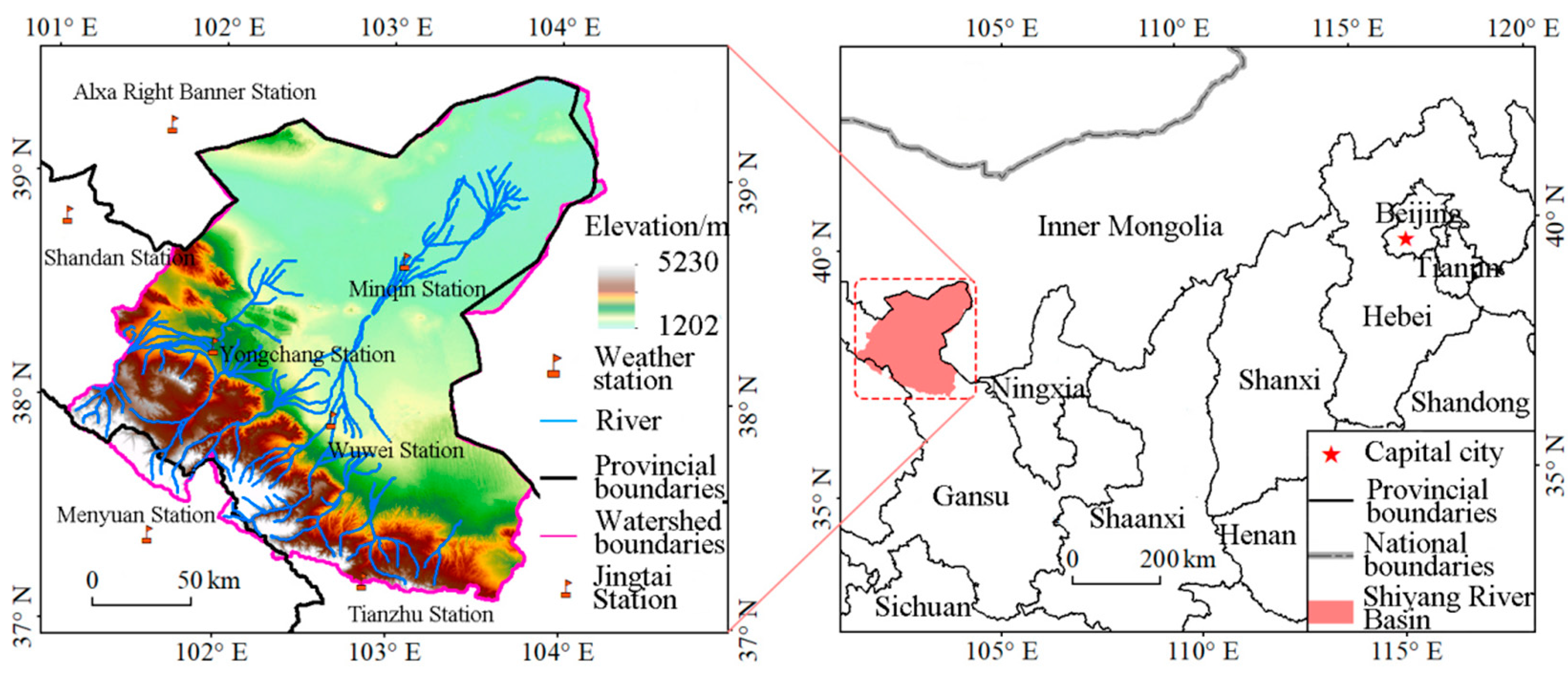
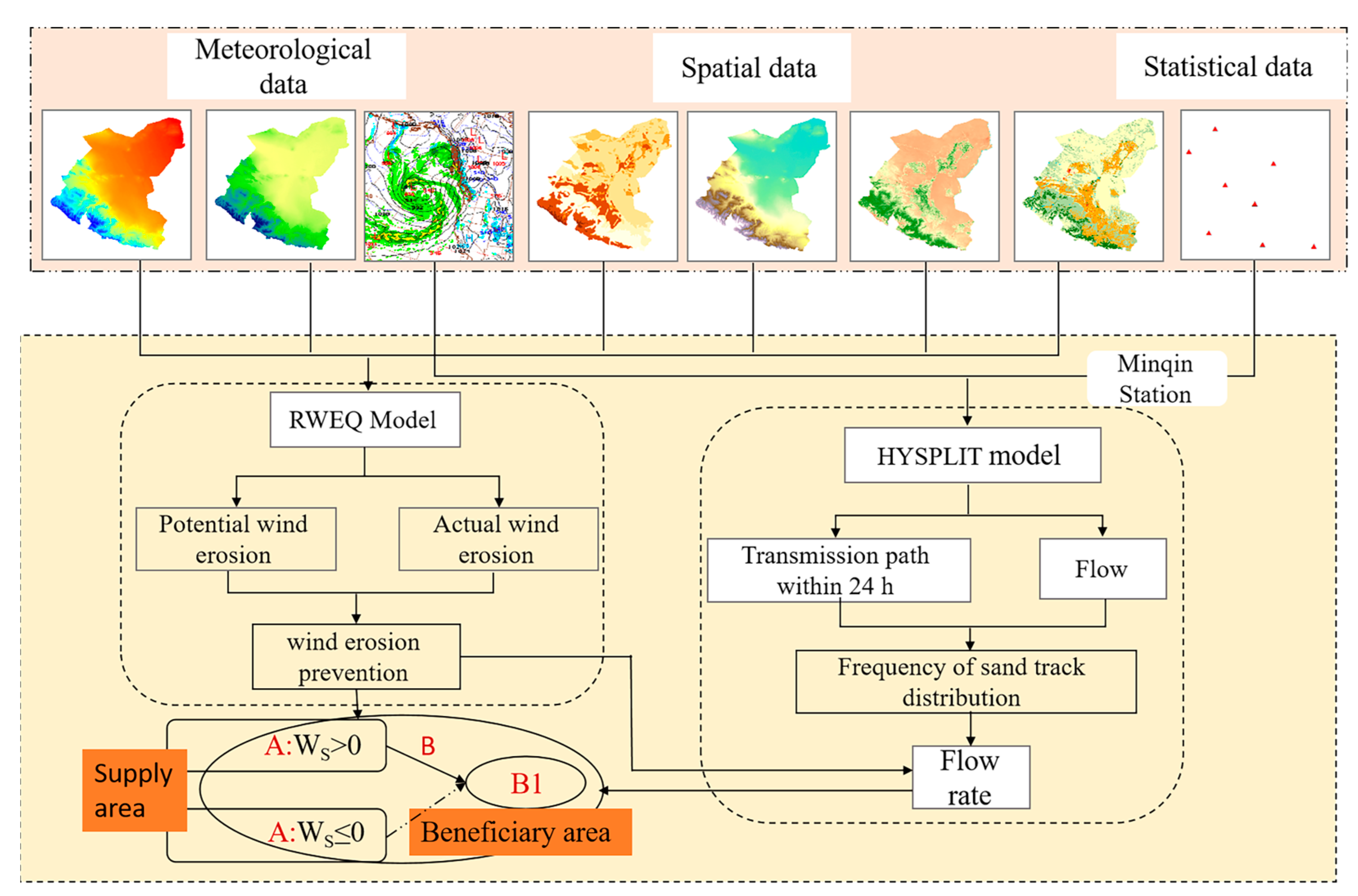
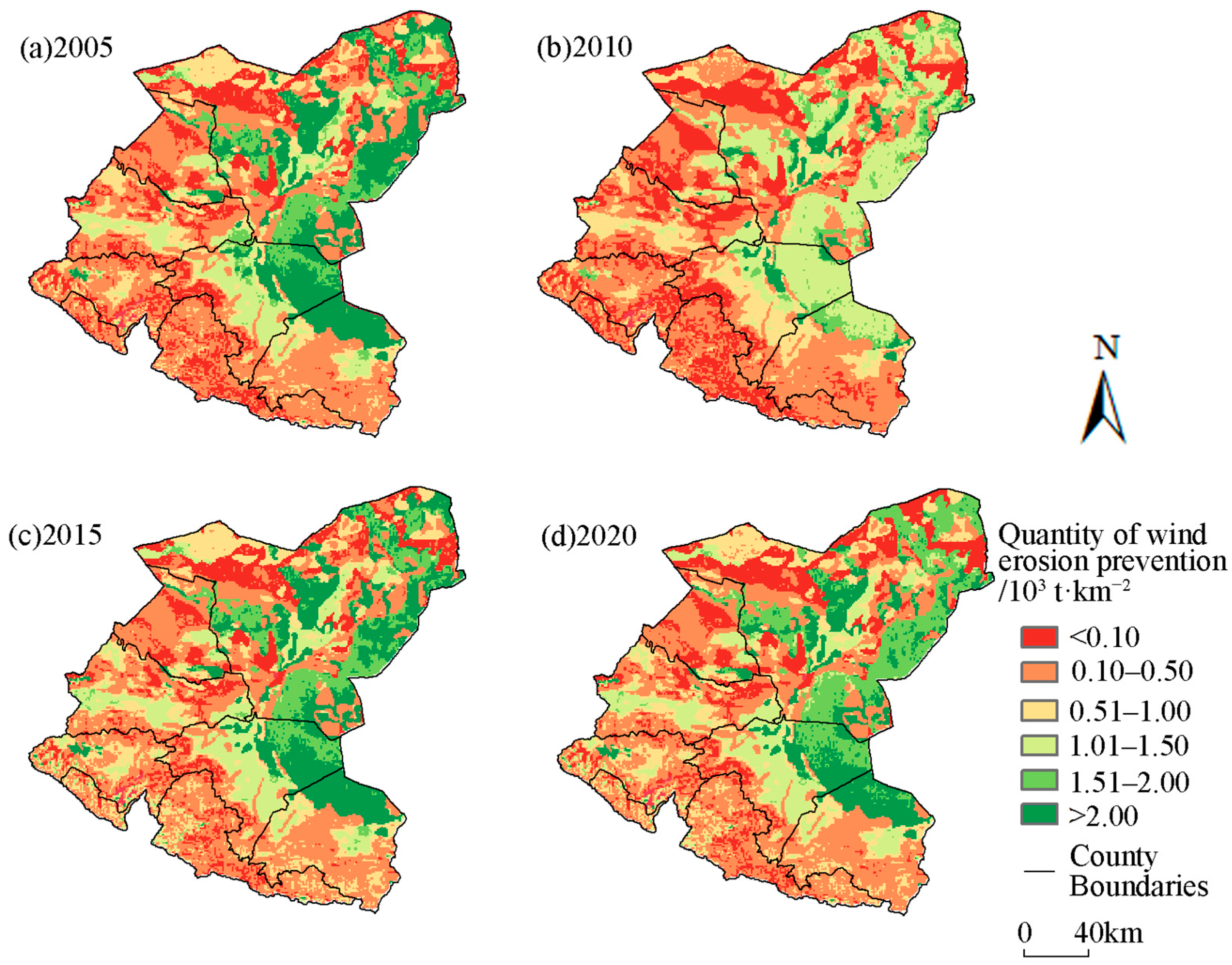
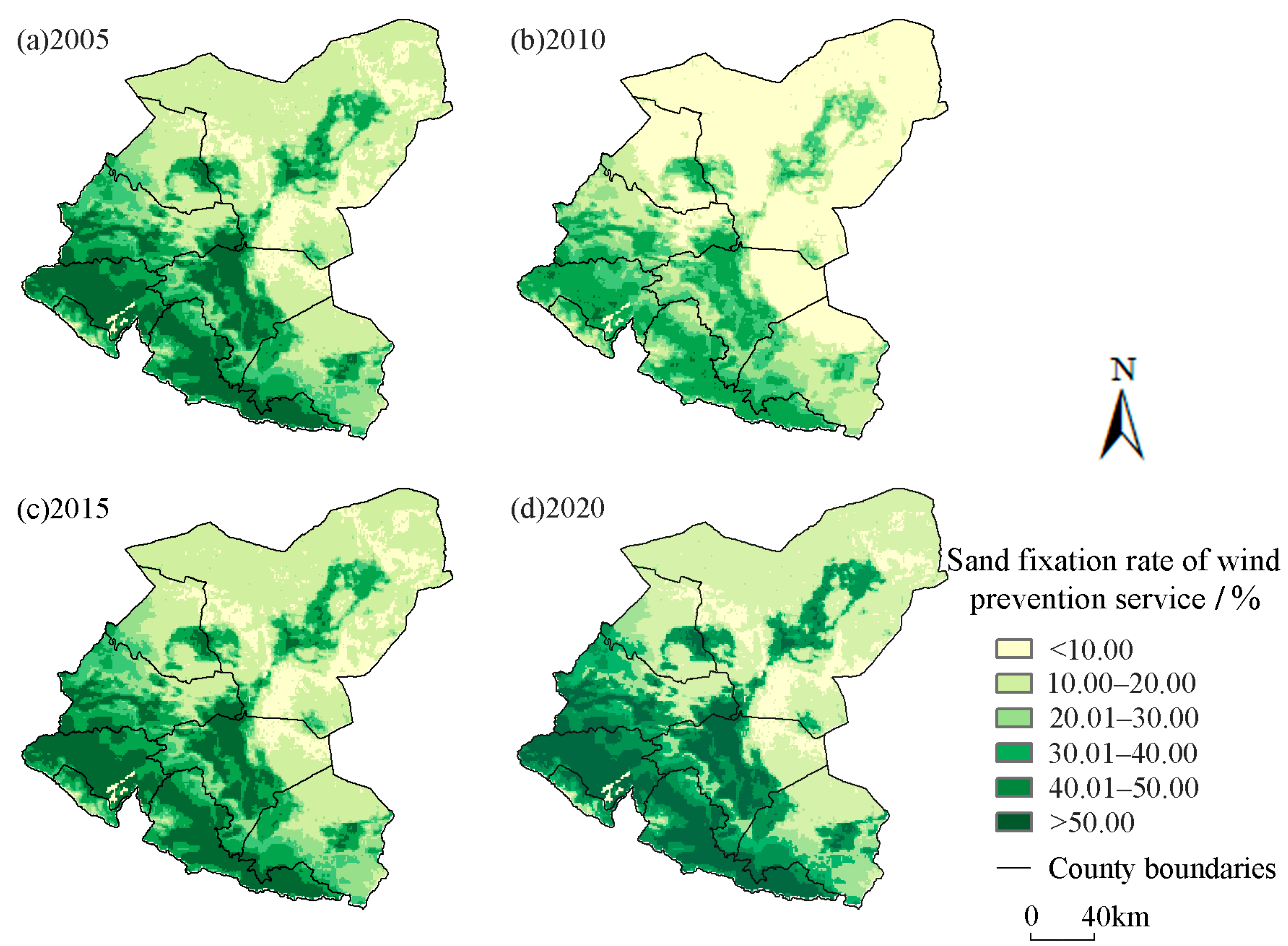
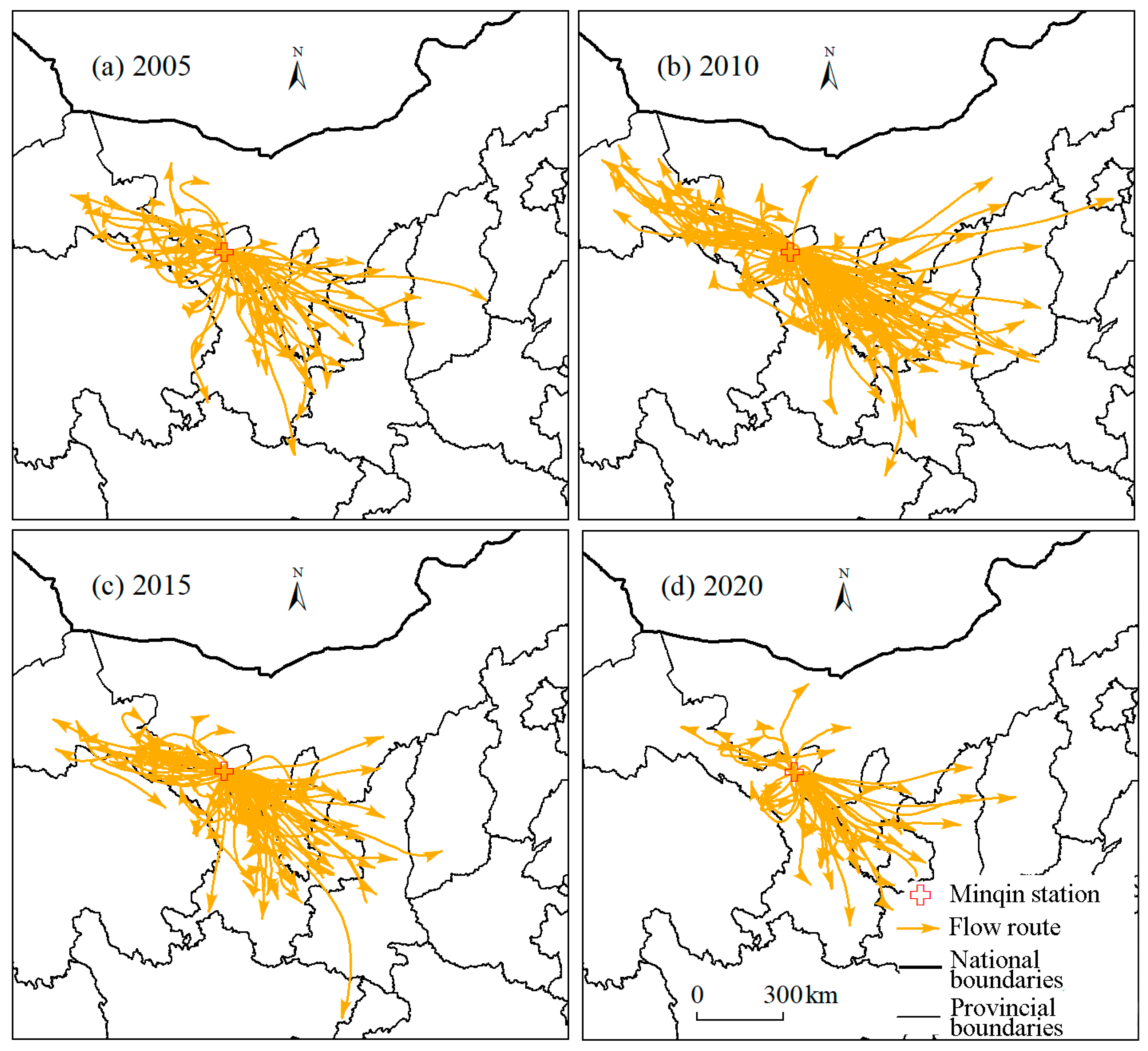
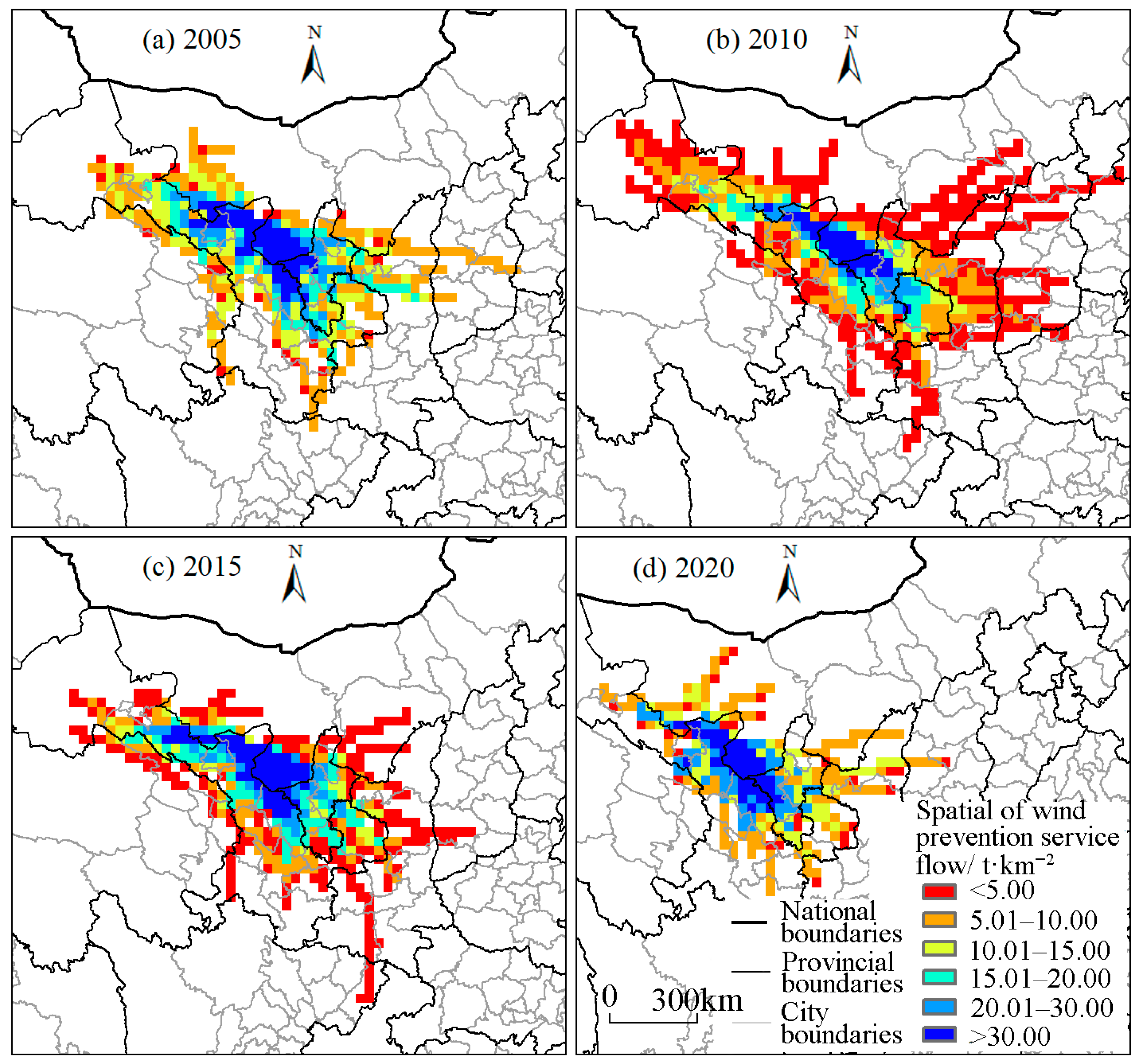
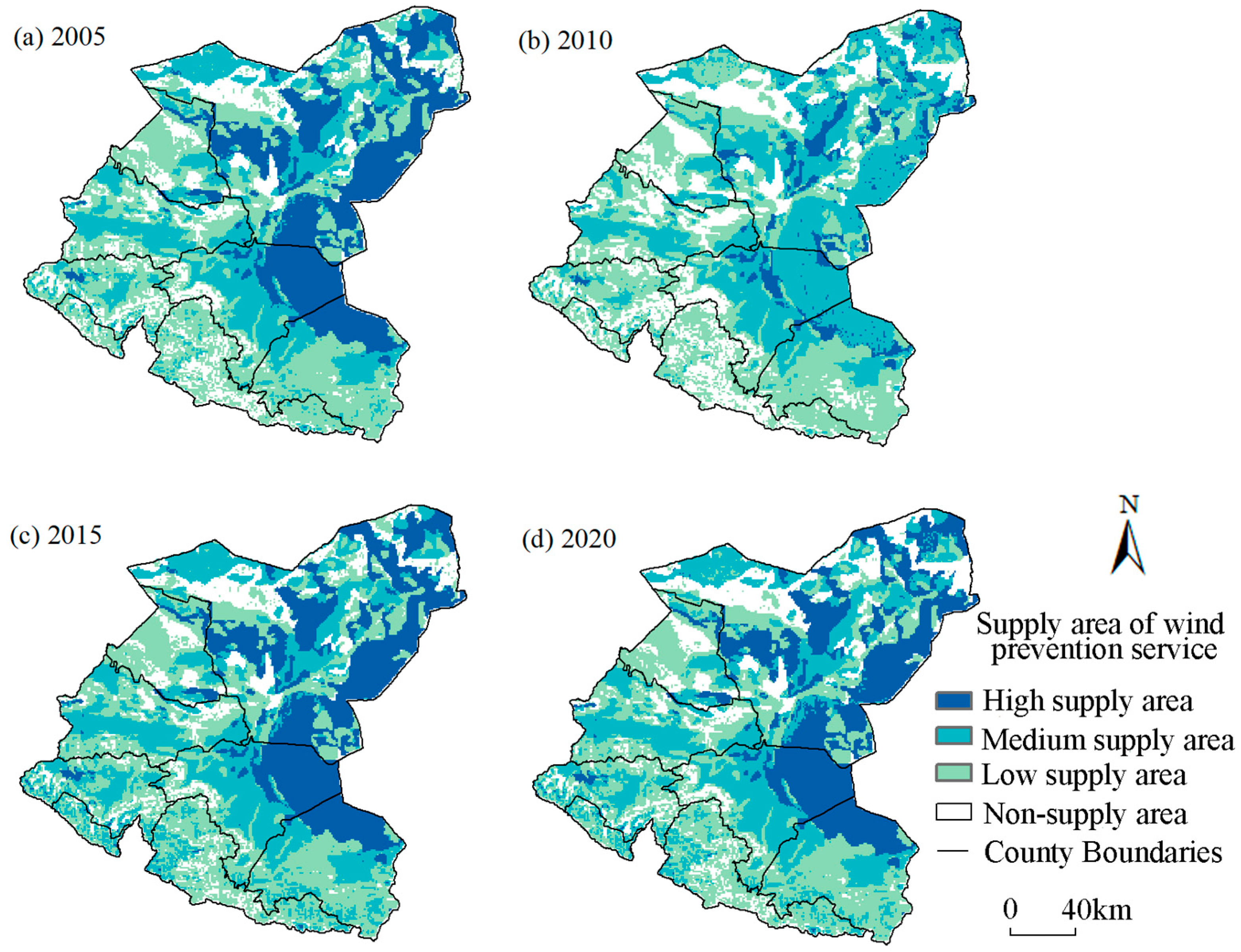
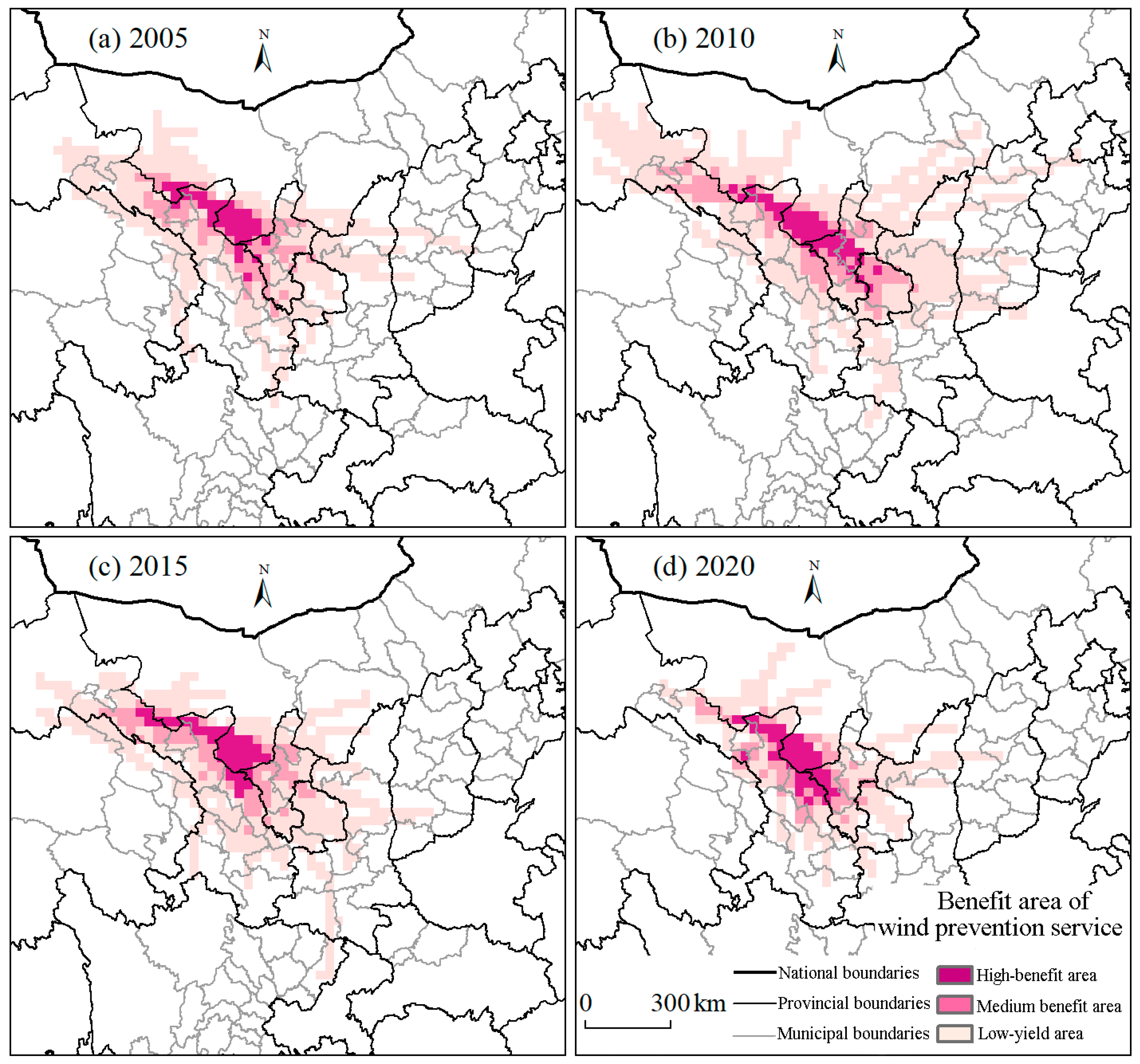
Disclaimer/Publisher’s Note: The statements, opinions and data contained in all publications are solely those of the individual author(s) and contributor(s) and not of MDPI and/or the editor(s). MDPI and/or the editor(s) disclaim responsibility for any injury to people or property resulting from any ideas, methods, instructions or products referred to in the content. |
© 2023 by the authors. Licensee MDPI, Basel, Switzerland. This article is an open access article distributed under the terms and conditions of the Creative Commons Attribution (CC BY) license (https://creativecommons.org/licenses/by/4.0/).
Share and Cite
Pan, J.; Wei, J.; Xu, B. Simulation of the Spatial Flow of Wind Erosion Prevention Services in Arid Inland River Basins: A Case Study of Shiyang River Basin, NW China. Atmosphere 2023, 14, 1781. https://doi.org/10.3390/atmos14121781
Pan J, Wei J, Xu B. Simulation of the Spatial Flow of Wind Erosion Prevention Services in Arid Inland River Basins: A Case Study of Shiyang River Basin, NW China. Atmosphere. 2023; 14(12):1781. https://doi.org/10.3390/atmos14121781
Chicago/Turabian StylePan, Jinghu, Juan Wei, and Baicui Xu. 2023. "Simulation of the Spatial Flow of Wind Erosion Prevention Services in Arid Inland River Basins: A Case Study of Shiyang River Basin, NW China" Atmosphere 14, no. 12: 1781. https://doi.org/10.3390/atmos14121781
APA StylePan, J., Wei, J., & Xu, B. (2023). Simulation of the Spatial Flow of Wind Erosion Prevention Services in Arid Inland River Basins: A Case Study of Shiyang River Basin, NW China. Atmosphere, 14(12), 1781. https://doi.org/10.3390/atmos14121781





